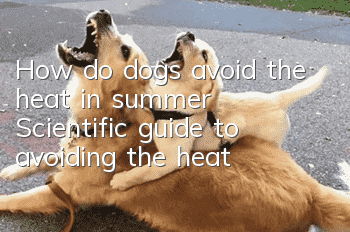How do dogs avoid the heat in summer? Scientific guide to avoiding the heat

Symptoms of summer heatstroke in dogs
Dogs’ bodies have very poor adaptability to external temperatures, and they are one of the animals prone to heatstroke. It manifests as elevated body temperature, shortness of breath, restlessness, dizziness and convulsions. In severe cases, vomiting, pulmonary congestion, nasal congestion, and even death may occur.
How do dogs avoid the heat in summer?
1. Do not go out to walk your dog in hot weather. The main areas of heat dissipation in dogs are the soles of their feet and their tongues. In the hot summer, the road surface temperature is higher than the air temperature. The heat dissipation function of the soles of the dog's feet is weakened, making it easy for heat stroke. If the ground temperature is too high, it is easy to cause burns on the foot pads.
2. Fill the used Coke bottle with water, cap the bottle and put it in the refrigerator. When the water is completely frozen, take it out and put it into the doghouse. Dogs will naturally run off to enjoy their "summer retreat." Or prepare an ice pad for your dog.
3. Turn on the fan or turn on the air conditioner appropriately to maintain indoor ventilation.
4. Make sure the dog has enough drinking water and change it regularly to ensure the water is fresh and clean.
5. Never lock your dog in the car or trunk when you take your dog out, as this may cause your dog to die of heatstroke.
6. Don’t let them engage in strenuous exercise.
Misunderstandings about dogs avoiding the heat in summer
1. Take frequent baths. Pet skin can secrete a protective film. Bathing too frequently will wash off the protective film, which is detrimental to the pet's health. In summer, small dogs should be washed once a week, and large dogs should be washed once every half month.
2. Shaving to dissipate heat. Dogs have almost no sweat glands on their body surface, so shaving their fur doesn't actually help dissipate heat very well. However, for long-haired dogs, it is still necessary to clean and cut the long hair on the body to enhance convection conduction, which is beneficial to the heat dissipation of the body surface.
Old dogs need to be cared for more carefully (special reminder)
Young dogs have better body temperature coordination and generally do not need special care; however, dogs over 89 years old need Special care. Elderly dogs’ body temperature rises in summer, air pressure changes, and their cardiopulmonary function weakens, which may lead to potential heart disease.
- What do dogs eat to protect their stomach? It is important to protect their stomach and treat gastrointestinal diseases in dogs.
- How to tell if your dog is fat? Is your dog overweight?
- Will your dog catch a cold if you blow the air conditioner? What should you do if your dog catches a cold if you blow the air conditioner?
- What should you pay attention to when your dog drinks water? Don’t be careless when it comes to your dog’s drinking water.
- The dog's mouth bites and shakes. Why does the dog's mouth occasionally shake and bite?
- How to cut a dog's hair? Do you know how to cut a dog's hair correctly?
- Can dogs eat raw eggs? Why can’t dogs eat egg whites?
- Common Dog Problems in Summer How to Deal with Different Dog Problems
- How to keep dogs away from skin diseases. If you do this, will you see if your dog will still be infected with skin diseases?
- What causes anorexia in dogs? Dogs will become anorexic due to lack of exercise. Hounds run at least 5KM every day.



